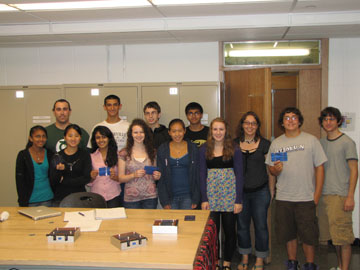THE EFFECTS OF SPACE ENVIRONMENTS ON SOLAR CELLS
Laura Bruce, Brian Dawes, James Horner, Krupa Patel, Ronak Patel, Nicholas Porto, Steven Scarfone, Olivia Shabash, Priyanka Shah, Daphne Sun, Jisoo Yoon
Advisor: Dr. Paul Quinn
Assistant: Sally Warner
|
ABSTRACT
Solar cells are widely used to power satellite missions in space because they use the sun's light to generate electricity. This project was conducted to gain a better understanding of how solar cells perform under extreme environmental conditions like those found in space. In order to find the optimum light source that best simulates sunlight, eight solar cells were tested to get their baseline currents and voltages using six different types of light bulbs with varying intensities. Each solar cell was then remeasured for its voltage and current after being immersed in liquid nitrogen, baked in an oven, or exposed to radioactive strontium-90. It was found that extreme heat adversely affected the cells, whereas successive cooling possibly improved the performance of the cell. The radiation results indicated that exposure to beta decay caused changes in the solar cells, affecting their function in a manner that will become more apparent with further testing. This project yielded fundamental and crucial information for further experiments that will help understand how solar cells function under different conditions in space. |


